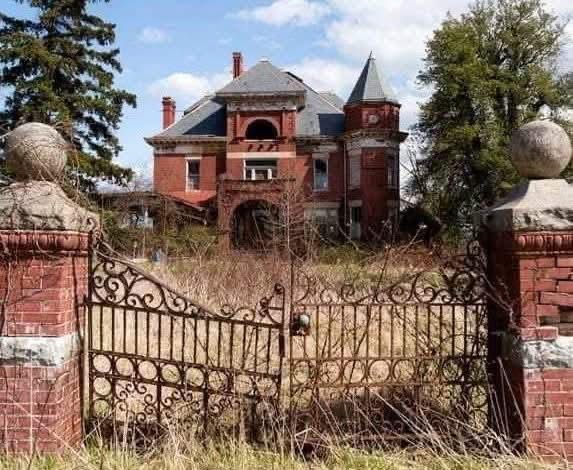
History and photo inside this house
Nestled in the charming town of Farmville, Virginia, amidst the rolling green fairways of a bustling golf course, stands the Dunnington Mansion — a once-stately home now shrouded in the quiet melancholy of abandonment. Known also by the name Poplar Hill, this mansion carries the weight of centuries, with its bricks and mortar echoing stories of prosperity, family, and the passage of time.
Origins: From Brick Farmhouse to Tobacco Baron’s Estate
The mansion’s origins trace back to an era when Farmville was largely a rural farming community, dotted with simple brick farmhouses and expansive tobacco fields. Initially, the structure was a modest brick farmhouse, functional and unpretentious, designed to support the agricultural lifestyle of the region.
Everything changed in 1897 when the Dunnington family took possession of the property. Walter Dunnington, a man who would grow to become one of the most influential tobacco barons in Virginia, saw potential beyond the humble farmhouse. Under his direction, the home was extensively expanded and transformed into an imposing Victorian mansion — a symbol of wealth, status, and architectural grandeur.
Walter’s success in the tobacco industry provided the financial resources to create a home that reflected not just his affluence but his vision for enduring legacy. The mansion became an embodiment of Victorian elegance, with intricate craftsmanship and design elements that echoed the opulence of the late 19th century.
Architectural Grandeur and Design
Poplar Hill is notable for its complex and ornate architecture. Despite its evolution from a farmhouse, the mansion grew to exhibit hallmark features of Victorian design: asymmetrical facades, decorative trim, and elaborate woodwork. One of its most fascinating features is its interior layout — a sprawling space filled with multiple staircases that wind and twist through the mansion, creating a labyrinthine effect that can easily disorient even the most seasoned visitor.
These staircases aren’t just practical elements; they serve as symbolic passages through the mansion’s many stories, both literal and figurative. Each room, hallway, and corner reflects painstaking attention to detail, from hand-carved banisters to stained glass windows that filter sunlight in a kaleidoscope of colors.
The mansion’s grounds were once equally impressive, with gardens, carriage houses, and outbuildings supporting the lifestyle of the Dunnington family and their guests. The estate was a hub of social and economic activity, closely tied to the tobacco trade that powered much of Virginia’s prosperity.
The Dunnington Legacy
Walter Dunnington’s passing in 1922 marked the end of an era. He left the mansion to his wife, India Dunnington, who would continue to live there with remarkable longevity. India remained in Poplar Hill for nearly a century, witnessing the world change dramatically around her while maintaining the home’s dignity and grace.
Her life stretched on until 1960, when she passed away at the extraordinary age of 103. India’s near-century-long presence at the mansion created a direct, living link to the Victorian era and the tobacco fortunes that had shaped the region.
Following her death, the mansion entered a more uncertain phase. From 1960 to 1998, the property was maintained, but little is documented about this period. The lack of extensive records suggests the mansion faded into relative obscurity, with its upkeep minimal and its presence more shadow than light.
Modern Challenges and Decline
In 2000, there was a glimmer of hope. The mansion was purchased by developers who envisioned restoring Poplar Hill to its former glory, perhaps adapting it as a venue for events or guest accommodations. Its prime location, nestled within an active golf course, seemed ideal for combining historical charm with modern leisure.
Unfortunately, economic downturns and shifting priorities stalled these plans indefinitely. Without proper investment and maintenance, the mansion’s condition deteriorated rapidly. Today, the once-majestic Dunnington Mansion stands abandoned, its walls succumbing to the ravages of time, weather, and neglect.
The golf course that surrounds the property still holds hopes for restoration, but the mansion’s future remains precarious. Every broken window and peeling shutter serves as a reminder of the delicate balance between preservation and decay faced by many historic homes.
A Testament to Virginia’s Architectural Heritage
Despite its current state, the Dunnington Mansion remains an important architectural and historical landmark. It stands as a poignant testament to Virginia’s rich past — a period when tobacco wealth shaped not only the economy but the cultural landscape. The mansion’s Victorian roots, intricate craftsmanship, and sprawling interiors continue to inspire historians, architects, and preservationists alike.
Its story is also a reminder of the impermanence of material splendor and the vital importance of safeguarding historic sites for future generations. The mansion holds within it echoes of the people who lived there, the laborers who built it, and the countless lives intertwined with its legacy.
Looking Ahead: Preserving Poplar Hill
Communities across the United States face similar challenges with historic properties. Many stand at a crossroads — saved and celebrated, or forgotten and lost. The Dunnington Mansion’s story is still being written. Whether through renewed preservation efforts, community fundraising, or visionary development, there remains hope that Poplar Hill can be revived.
Such efforts require collaboration between local authorities, historical societies, preservation groups, and private stakeholders. With careful planning and commitment, it’s possible that the mansion will once again open its doors to the public, offering a glimpse into Virginia’s past while serving contemporary cultural and social needs.
Until then, the mansion remains a silent sentinel, watching over the green fairways and whispering stories of tobacco barons, Victorian elegance, and a family whose legacy shaped an era.





